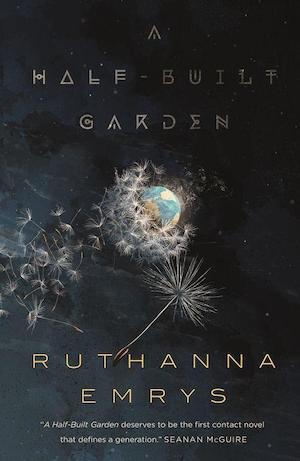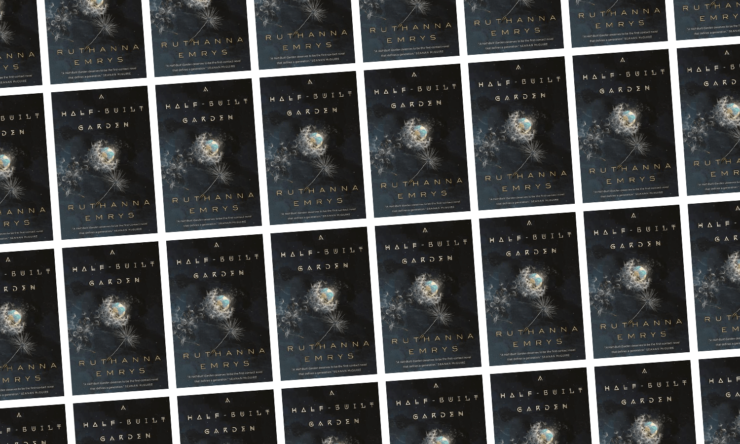The world of Ruthanna Emrys’ A Half-Built Garden is fascinating even before the aliens show up. It’s 2083 and humanity has fractured into a host of smaller social organizations, including weakened central governments, technologically-advanced micronations, and local networks that maintain distinctive technological and ecological presences.
It’s in one of these communities in the Chesapeake Bay Watershed that protagonist Judy Wallach-Stevens resides. What initially seems like odd scientific readings prove to be something different—the arrival of alien beings. It turns out that communications won’t be a problem, as the new arrivals have centuries’ worth of popular culture to learn from. But interacting with interstellar visitors soon becomes highly in demand—and given that Judy was the first to meet them, she soon finds herself at the center of numerous negotiations.
All of this means that A Half-Built Garden is as much about first contact and the relationship between humans and extraterrestrials as it is the political dealings that arise in the aftermath of that moment. Patricia Anthony’s Brother Termite and Cadwell Turnbull’s The Lesson both come to mind, though Emrys is charting very different territory from either of those novels.
It’s probably worth pointing to Emrys’ Innsmouth Legacy series here, which works to take what was uncanny in H.P. Lovecraft’s work and make it familiar. While A Half-Built Garden differs in countless ways from her earlier work, Emrys is using both to ask questions about communities and insularity, and about how perception of Otherness can shift dramatically depending on who’s doing the perceiving.
Buy the Book


A Half-Built Garden
The aliens, known as the Ringers, represent two distinct species, referred to as plains-folk and tree-folk. They are eager to engage with humanity, and have achieved proper intergalactic travel and other stunning technological feats—there’s mention of a Dyson sphere at one point. But that philosophy comes at a cost: they believe that all sentient species must abandon their home planets to fully expand their civilization.
This, then, forms the great dilemma of the novel. Judy and her family are fully invested in working to make the planet a more livable place. Is it possible for them to do so but also embrace spacefaring? Whether or not this is an either/or situation is a question that hovers over the action; at its core, this is a book about ethics and grand ideas. As if to underline this, Emrys occasionally has Judy reflect on her own Judaism and the way that it informs some of the questions of home that this novel’s characters wrestle with.
Not all of those grand ideas emerge from the plot. There’s a scene in which Judy travels to Zealand, an “aisland” founded by technologists that offers a very different glimpse of how human society has changed in the near future in which this book is set. Judy describes the residents of Zealand as “the descendents of the people who’d arrived with their founder—allies and employees who’d prioritized fleeing apocalypse over creating community to stop it.”
The way that social hierarchies, technology, and gender all function in Zealand compared to Judy’s home in the Chesapeake Bay Watershed Network makes for an interesting study in contrasts all its own, and the tension between the two communities could probably fuel a compelling novel on its own without bringing interstellar travelers into the mix.
This isn’t a book that lacks for ambition, however. It’s an ecological narrative, a tour of late 21st century Earth, and a detailed novel of first contact all at once. That can leave a few subplots feeling somewhat underdeveloped; Judy’s growing romantic feelings for one of the tree-folk ends up becoming a fairly important plot point later in the book, but that connection didn’t entirely click for me as much as some of the other bonds and conflicts did.
In addition to the grand ideas Emrys raises over the course of the book, what stands out most about A Half-Built Garden is the way it tells a story with the highest of stakes without ever feeling the need to create a false sense of danger or compromising its characters to advance the plot. This isn’t a book in which the aliens are too good to be true; there’s no “It’s a cookbook!” moment here. Instead, Emrys has created a story where the central characters have the best intentions and where the focus is on societal and moral questions rather than a literal ticking time bomb. It’s a novel of ideas that remains true to its ideals.
A Half-Built Garden is available from Tordotcom Publishing.
 Tobias Carroll is the managing editor of Vol.1 Brooklyn. He is the author of the short story collection Transitory (Civil Coping Mechanisms) and the novel Reel (Rare Bird Books).
Tobias Carroll is the managing editor of Vol.1 Brooklyn. He is the author of the short story collection Transitory (Civil Coping Mechanisms) and the novel Reel (Rare Bird Books).










